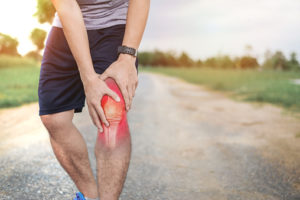Many people who suffer from osteoarthritis are on conventional pain killers and are still not getting effective pain relief. Or their pain is managed for now, but the arthritis and the associated damage is getting worse. I’ve also heard from my clients and patients that they wish they could have a joint replacement now, but are too young, or the joint damage isn’t bad enough yet.

So what are your options??
One of the most commonly used natural supplement used in any inflammatory condition, but especially with osteoarthritis pain, is curcumin. You may know of it as turmeric, the spice used heavily in Indian cooking. Let’s take a look at the relationship between curcumin and osteoarthritis, and how it reduces inflammation and may even help slow the disease process.
First, let’s look at osteoarthritis. It’s a degenerative process, which means that the cartilage (basically the slippery coating on the bones) of the joint degrades, the bones of the joint begin to wear and remodel, and bony overgrowths form in inappropriate places. So how does this process start in the first place? Local damage like trauma, injury, or overuse of the joint causes local inflammation. This inflammation causes the release of “damage associated molecular patterns” from the deteriorating cartilage. These molecular patterns stimulate inflammatory cytokines (chemicals) that promote further deterioration of the cartilage releasing more damage associated molecular patterns, and thus a vicious cycle forms. These inflammatory cytokines also affect the mitochondria (aka the powerhouse of the cell, or the part that produces energy molecules) and thus energy production of cartilage cells. In addition, molecules associated with oxidative damage are released in response to this mitochondrial dysfunction and by some immune cells causing the death of cartilage cells. Many conventional pain killers treat the pain, but ignore the underlying cause of osteoarthritis, which is chronic inflammation that causes a vicious cycle of damage, more inflammation, oxidative damage, and cell death. NSAIDS are a conventional pain killer that also address inflammation but they can have nasty side effects like gastrointestinal toxicity as well as other more severe cardiovascular effects. As mentioned earlier, joint replacements are an option but these are only done in older patients and patients with severe disease, and this treatment is associated with the serious side effects of infection and deep vein thrombosis.

How curcumin works
So how does curcumin fit in? Curcumin is both anti-inflammatory and an anti-oxidant. Mechanistically, it’s been shown to reduce the levels of those inflammatory cytokines and prevents cell death. It also acts as a “free radical scavenger”, converting reactive oxygen species and other molecules associated with oxidative damage into safe forms, reducing oxidative damage on tissues. So theoretically, curcumin can help treat osteoarthritis, both symptomatically and mechanistically. This isn’t where the evidence ends though, many studies have been done on human participants with osteoarthritis using curcumin alone, curcumin with another anti-inflammatory herb called boswellia, curcumin with conventional anti-inflammatories and comparing it to usual conventional treatment or other natural products like glucosamine. These studies then look at objective and subjective markers of patient outcomes, including self reported pain levels and objective tests of joint functionality like pain free walking time.
To summarize these studies, most studies found that curcumin was as effective in pain relief as conventional treatment but without the harsh side effects. Those studies that looked at longer term treatment (3+ months) also showed a greater level of decrease in an inflammatory cytokine called c-reactive protein over conventional treatment. Curcumin plus glucosamine was compared to chondroitin plus glucosamine for 4 months, and it was shown that not only did curcumin plus glucosamine decrease pain to a greater extent than the chondroitin plus glucosamine group, but also measures of joint functionality. On a cellular level, curcumin has been shown to prevent cartilage cell death, reduce a broad range of inflammatory chemicals, and when combined with green tea, suppressed the gene expression that leads to inflammatory chemicals.
How to choose a product
Something often talked about when discussing supplementing curcumin (or any product actually) is the bioavailability. This means how much of a dose given to a patient will actually be absorbed by the body and available for use. Unfortunately for the curry eating community, turmeric the spice is not a particularly bioavailable substance. So when you eat a curry, or turmeric dissolved in water, you are not actually absorbing that much. What is found in animal studies is that strategies to improve the bioavailability of curcumin (combining with fat particles, adding black pepper) can increase the absorption by up to 5 times. One of the best absorbed versions studied so far is a form called Meriva, which is formulated with phosphatidylcholine. Another up and comer is Theracumin which shows very high levels in plasma after liquid or capsule supplementation. What we can conclude from this, is that turmeric the spice alone is not enough to get clinical improvement, and that a supplement formulated to be more bioavailable is necessary.
To sum up, what these studies suggest is that curcumin supplementation is as effective as conventional pain killers and anti-inflammatories in as little as a few weeks, and can improve joint functionality with longer term treatment, all with less side effects. We know that mechanistically, curcumin can treat not only the symptoms of osteoarthritis but also the underlying cause of the disease, possibly slowing down the disease process. It also combines well with other treatments, like conventional pain killers, glucosamine, green tea, and boswellia. So, turmeric is definitely more than just a beloved spice, it’s a powerful antioxidant and anti-inflammatory that could be helpful for those with osteoarthritis.
References
Chin, K. The spice for joint inflammation: anti-inflammatory role of curcumin in treating osteoarthritis. Drug Design, Development and Theory. (2016). 10:3029-3042.




